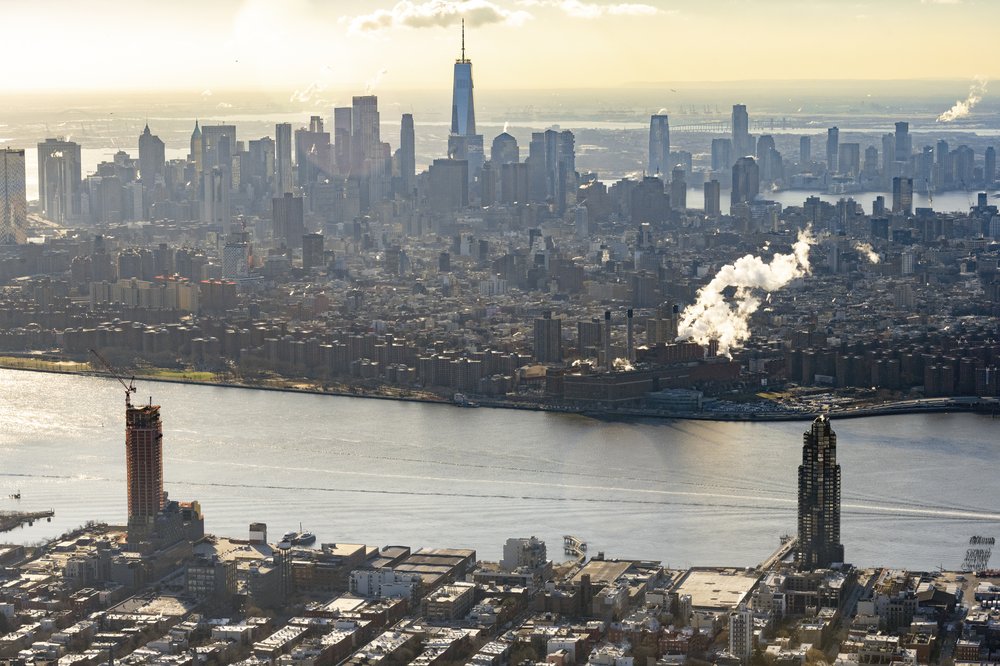NYC’s air is ‘as clean as it’s ever been,’ but that’s still pretty gross
April 26, 2023, 5:01 a.m.
Clean air policies are working, environmental experts said — just not fast enough.

The air we breathe in New York City has gotten a lot cleaner over the past decade, according to a new report released by the city health department.
Air monitoring data shared last week in the latest New York City Community Air Survey shows that concentrations of dangerous pollutants particulate matter 2.5 (PM2.5) and nitrogen oxide (NOx) declined by around half citywide between 2009 and 2021. Sulfur dioxide, a byproduct of burning certain types of fuel oil, almost disappeared entirely during that same time period.
“New York is as clean as it has ever been,” said Dr. Róisín Commane, an assistant professor of earth and environmental sciences at Columbia University.
The improvements have coincided with fewer asthma ER visits and hospitalizations for some New Yorkers, city and state data show. Infants, toddlers and preschool-aged kids made about as many ER trips for asthma attacks in 2019 as they did a decade prior.
Experts and city health officials alike attributed the progress to policy changes, like weaning the city off of especially polluting heating oil. But they said there’s still a lot of work to be done, especially around contaminants like ozone.
“I’m not saying it’s clean,” Commane immediately clarified. “I’m saying it’s a lot cleaner than it’s been.”
Concentrations of ozone, an irritating compound formed when other air pollutants react with heat and sunshine, remained stable during the study period. The American Lung Association, which grades counties on their air quality, ranks the New York metro area 12th-worst out of 227 cities for high-ozone days.
To collect data for the NYC Community Air Survey, city health department officials and researchers from Queens College strapped close to 100 battery-powered air samplers to lampposts around the five boroughs. The monitors used pumps and filters to collect samples over a few weeks each summer and winter between 2009 and 2021.
- heading
- At a glance
- image
- image
- None
- caption
- body
- Air quality has improved substantially in NYC over the last decade.
- Some pollutants have dropped dramatically thanks to policy changes. Others have remained stable.
- Breathing in these contaminants can cause health problems, especially for kids, seniors, people with breathing conditions and people who work outdoors.
- Air quality experts said vulnerable people should try and stay inside on high-pollution days. You can check pollutant levels online and sign up for air-quality alerts through NotifyNYC.
The researchers turned the data into a map of air pollution across the city, using statistics and high-emission landmarks to fill in the gaps between sampling stations. They found that, despite the improvements, New Yorkers who live close to industrial areas, high-traffic roads and warehouses are still exposed to more air pollution than their neighbors.
Buildings are a major source of emissions, too, so living in densely populated areas of the city translates into more pollutant exposure. City officials said that restaurants that use grills or charbroilers are a big contributor of PM2.5, the pollutant particles whose tiny size allows them to invade our lungs.
Breathing in these pollutants can wreak havoc on our health. Effects range from coughing and wheezing to asthma attacks, heart problems, low birth weight and even premature death. Children, older adults, people who work outdoors and those with preexisting breathing problems are especially vulnerable. That means that air pollution can disproportionately affect Black and Latino New Yorkers, who have higher rates of asthma than their neighbors of other races and ethnicities, according to city data.
These inequities mean that slashing building and vehicle emissions isn’t enough, said Jaron Burke, environmental health manager at WE ACT for Environmental Justice. Indoor air quality, which can be compromised by pests, mold and under-ventilated gas stoves, is also crucial to our health, he added.
“It’s kind of a hidden thing that people don’t know about,” he said. “There's so many people in New York City that have a gas stove in their home and just aren't really thinking about how that's impacting their health.”
Burke and Commane both urged city and state officials to keep pushing on climate goals, like electrifying buildings and phasing out gas-burning cars.
The city isn’t the only one keeping tabs on air quality. Car-mounted sensors prowled city streets last summer for a $3 million state-sponsored project to map air pollution at the block level. You can also sign up for air quality alerts via NotifyNYC and check sensors near you using the Environmental Protection Agency’s AirNow tool.
On really nasty days, city health officials recommend that New Yorkers limit time outside, especially if they’re vulnerable to air pollution.
Electric vehicles make up 1% of NYC cars. Will an EPA emissions crackdown spark a boom? ‘A layer cake of environmental pollution’: Greenpoint struggles with rezoning 18 years on